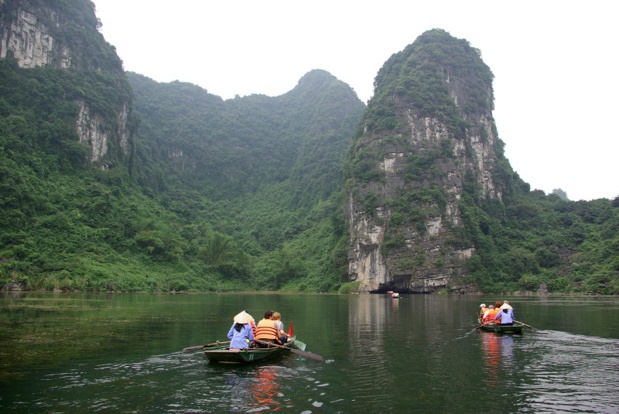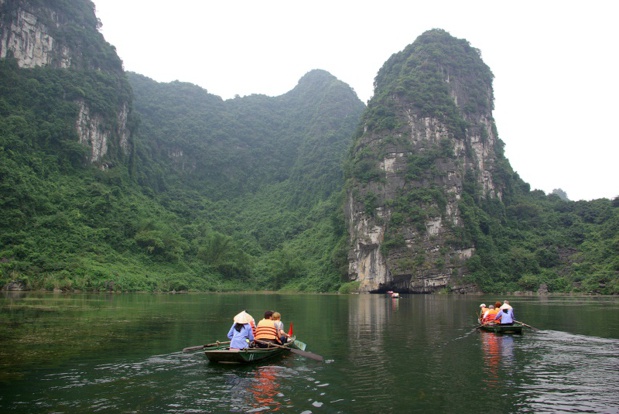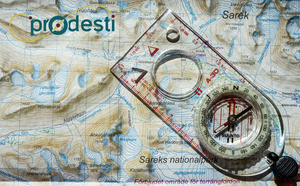
Twins of the famous Ha Long Bay and its famous sugar loaf mountains, the site of Trang An provides an astonishing landscape of cliffs, calcareous pitons, and Karst caves. To the extent that it is named a “terrestrial Ha Long Bay.” - DR: J.-F. R.
We are at the extreme north of Vietnam, close to the Chinese border.
Our car stops in the Hmong de Lao Chai village, at the foot of misty mountains. A swarm of women in traditional clothing rush to sell their handicrafts.
Even though the confrontation could shock, this isolated region that is home to ethnic minorities isn’t invaded by visitors.
This is Vietnam’s paradox, a country with 3,260 km of coastline. In the South and Center, Hô Chi Minh city, the festive, and the Mekong delta, along with the seaside resort Da Nang and the royal Hue, all attract tourists.
As a result they ignore Hanoi and the Northern provinces that are yet solid pillars of Vietnamese identity.
Things could change. Under the impetus of a Communist State that has opened the doors of its economy in the last twenty years, the North is getting ready.
Symbol: the Lotte Hotel, in Hanoi. With its 267 meters brand-new tower, the establishment, five stars, and the rooftop bar-terrace have become the capital’s “it” spots.
From the rooms, clients can look over a city of 3.5 million inhabitants spiked with white towers erected around urban lakes.
This upgrading is paired with the imminent opening of the airport’s new international terminal.
Our car stops in the Hmong de Lao Chai village, at the foot of misty mountains. A swarm of women in traditional clothing rush to sell their handicrafts.
Even though the confrontation could shock, this isolated region that is home to ethnic minorities isn’t invaded by visitors.
This is Vietnam’s paradox, a country with 3,260 km of coastline. In the South and Center, Hô Chi Minh city, the festive, and the Mekong delta, along with the seaside resort Da Nang and the royal Hue, all attract tourists.
As a result they ignore Hanoi and the Northern provinces that are yet solid pillars of Vietnamese identity.
Things could change. Under the impetus of a Communist State that has opened the doors of its economy in the last twenty years, the North is getting ready.
Symbol: the Lotte Hotel, in Hanoi. With its 267 meters brand-new tower, the establishment, five stars, and the rooftop bar-terrace have become the capital’s “it” spots.
From the rooms, clients can look over a city of 3.5 million inhabitants spiked with white towers erected around urban lakes.
This upgrading is paired with the imminent opening of the airport’s new international terminal.
The sparkling Hanoi
Autres articles
-
 Le Monténégro, la nouvelle star des Balkans ?
Le Monténégro, la nouvelle star des Balkans ?
-
 Naufrage meurtrier au Vietnam : un bateau chavire en pleine croisière
Naufrage meurtrier au Vietnam : un bateau chavire en pleine croisière
-
 Vacances 2025 : les Français entre envie d’évasion et contraintes économiques
Vacances 2025 : les Français entre envie d’évasion et contraintes économiques
-
 Expert d'une destination : comment se former, se spécialiser et en faire un levier de vente ? [ABO]
Expert d'une destination : comment se former, se spécialiser et en faire un levier de vente ? [ABO]
-
 Easia Travel, Réceptif Vietnam
Easia Travel, Réceptif Vietnam
The contrast is striking between this luxury and the spark of an ultra working-class city.
Amongst sellers with conical hats and men wearing the green helmets of Viet Minh soldiers, there’s a cacophony of infernal scooter traffic.
In the old quarter of corporations and of the large Dông Xuan market, the population density is incredible intertwined with the smells of spices, grilled meats, and tropical fruits.
Is Hanoi as austere as we say? Not sure, even though the nightlife is calmer than in Hô Chi Minh (former Saigon).
The French clientele will surely appreciate the colonial ruins, a reminder of our presence in Indochina: old houses with decayed façades; the Opera (1911), inspired by the Parisian Garnier palace; the former governor’s palace, that then became the home of “uncle Hô” (Hô Chi Minh); Saint-Joseph Cathedral (1886); the venerable Doumer metallic bridge, on the Red River, that upholds pedestrians, motos, and trains since 1902.
Amongst sellers with conical hats and men wearing the green helmets of Viet Minh soldiers, there’s a cacophony of infernal scooter traffic.
In the old quarter of corporations and of the large Dông Xuan market, the population density is incredible intertwined with the smells of spices, grilled meats, and tropical fruits.
Is Hanoi as austere as we say? Not sure, even though the nightlife is calmer than in Hô Chi Minh (former Saigon).
The French clientele will surely appreciate the colonial ruins, a reminder of our presence in Indochina: old houses with decayed façades; the Opera (1911), inspired by the Parisian Garnier palace; the former governor’s palace, that then became the home of “uncle Hô” (Hô Chi Minh); Saint-Joseph Cathedral (1886); the venerable Doumer metallic bridge, on the Red River, that upholds pedestrians, motos, and trains since 1902.
Hmong, Thaïs, Dzaos…
And let’s talk about this train. In 8-9 hours with night equipment, 1st class comfortable bed-wagons (but overwhelmingly loud), you’ll be transported from Hanoi to Lao Cai, at the Chinese border.
We’re at the heart of the country of ethnic minorities who have been living here for centuries.
Inside a tacky fog, the road rises to Sapa, at 1,650 meters of altitude.
Below this famously harsh climate are living Hmong, Dzaos, Thaïs, Giây villages… Many ethnicities that we learn to recognize with their traditional costumes, black skirts for Hmongs women, large red headscarves for the Dzaos…
Their living conditions are difficult. But crossing the hamlets by foot is extremely rewarding.
Between the smiles of inhabitants, the sight of cultivated rice terraces, grey buffalos, and wooden houses, rural Asia enchants.
We’re at the heart of the country of ethnic minorities who have been living here for centuries.
Inside a tacky fog, the road rises to Sapa, at 1,650 meters of altitude.
Below this famously harsh climate are living Hmong, Dzaos, Thaïs, Giây villages… Many ethnicities that we learn to recognize with their traditional costumes, black skirts for Hmongs women, large red headscarves for the Dzaos…
Their living conditions are difficult. But crossing the hamlets by foot is extremely rewarding.
Between the smiles of inhabitants, the sight of cultivated rice terraces, grey buffalos, and wooden houses, rural Asia enchants.
Trang An, the terrestrial Ha Long Bay
Another Asia surfaces two hours South of Hanoi in the last branches of the delta of the Red River.
Twin of the famous Ha Long bay and of its sugar loaf mountains, an equally beautiful, less visited sector, that is blossoming.
Indeed, the Tran An site offers an astonishing landscape of cliffs, calcareous pitons, and karst caves. To the extent that we call it - along with the neighboring sites of Tan Côc and Hoa Lu - a “terrestrial Ha Long Bay.”
In a rowboat, we can squeeze within a maze of waterways, underground passages, and fake lakes, bordered by temples and pagodas.
So beautiful that, in 2014, UNESCO added the site to its World Heritage list. Another reason to go explore North Vietnam.
Twin of the famous Ha Long bay and of its sugar loaf mountains, an equally beautiful, less visited sector, that is blossoming.
Indeed, the Tran An site offers an astonishing landscape of cliffs, calcareous pitons, and karst caves. To the extent that we call it - along with the neighboring sites of Tan Côc and Hoa Lu - a “terrestrial Ha Long Bay.”
In a rowboat, we can squeeze within a maze of waterways, underground passages, and fake lakes, bordered by temples and pagodas.
So beautiful that, in 2014, UNESCO added the site to its World Heritage list. Another reason to go explore North Vietnam.



























![De l’auberge de jeunesse au Generator : toute une histoire [ABO] De l’auberge de jeunesse au Generator : toute une histoire [ABO]](https://www.tourmag.com/photo/art/large_16_9/93247694-65219608.jpg?v=1765984636)















